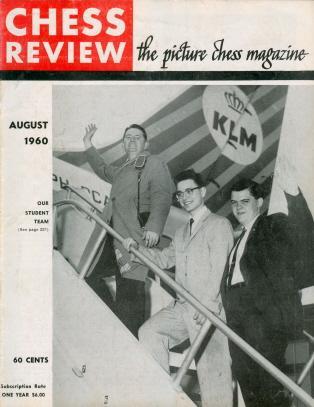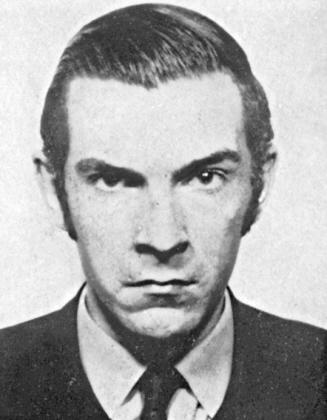Chess Explorations (35)
By Edward Winter
Our article Chess and the Wallace Murder Case relates a famous, particularly
baffling mystery, and occasional Chess Notes items have mentioned other connections
between chess and killing. Often, though, the information available is scant.
C.N. 3670 referred to the lethally charming Neville George Clevely Heath (born
1917), quoting a passage from page 189 of Portrait of a Sadist by Paull
Hill (London, 1960) which describes the killer’s last days, at Pentonville
Prison, London:
‘He spent a lot of time reading, made copious notes for his legal advisers,
played a certain amount of chess with the warders, two of whom were in his
cell day and night, and wrote a lot of letters to friends and his family.’

Neville George Clevely Heath
Neville Heath was hanged on 16 October 1946, the same day as, in Nuremberg,
Hans Frank
suffered the identical fate.
William George Heirens (see C.N. 3707) was a 17-year-old student at the University
of Chicago when, in 1946, he confessed to three murders. He became known as the
‘Lipstick Killer’ because on a wall in one of the victims’ homes
a message was found written in lipstick: ‘For heavens sake catch me before
I kill more. I cannot control myself.’ Although the evidence against Heirens
has been fiercely disputed, he is still in prison.

William Heirens
Page 102 of “Before I Kill More...” by Lucy Freeman (New
York, 1955) relates that at university Heirens had taken up chess, and on page
128 he is quoting as telling her:
‘Later I learned the psychiatrists that examined me were of the type
which only consider abnormalities that had a physical relationship, like tumors
on the brain, epilepsy and related diseases. They probably couldn’t
tell a person was possessed with a dual personality unless they examined a
Siamese twin.
There wasn’t a thing I could do about it. My counsel were running the
show. I was just a pawn to be pushed around the chess board and sacrificed
when it suited their whims.’
The case of the chess master Raymond Weinstein will be recalled.

Left to right: Jerry Spann (captain), Raymond Weinstein and
William Lombardy (world student team championship in Leningrad)
As recorded on page 127 of Chess Explorations (C.N. 1311), the late
Sidney Bernstein informed us in the 1980s:
‘I have it on most reliable authority (the author John Collins,
who was a close friend of Raymond Weinstein) that Weinstein (an extremely
strong and promising young player who finished third in the 1960-61 US Championship)
had been confined to a mental institution. While on temporary leave, he was
rooming with an older man who made derogatory remarks about Weinstein’s
mother. Raymond slit the man’s throat with a razor, and was, of course,
incarcerated permanently. Raymond’s mother is also in an asylum.’
Collins discussed Weinstein’s chess career on pages 195-235 of his book
My Seven Chess Prodigies (New York, 1974).
Another case in the United States has been extensively covered by other writers:
Claude Bloodgood.
As regards chessplaying victims, there are numerous accounts of the killing of the French master
Gilles Andruet in 1995. Abe Turner was murdered on the premises of Chess
Review in 1962. C.N.
6423 gave a photograph of Turner in play against Bobby Fischer in the final
round of the 1957-58 US Championship in New York.
C.N. 5441 mentioned that on 5 December 1924 Norman Thorne (1900-1925) of Crowborough,
England dismembered his fiancée Elsie Cameron. Earlier that day he had
bought ‘a game of chess’ in Tunbridge Wells. Source: page 114 of
The Trial of Norman Thorne by Helena Normanton (London, circa
1929). Much has been written about that famous murder case, but we recall no
other reference to chess in connection with the life of Thorne, who was hanged
on 22 April 1925.

John Norman Holmes Thorne giving evidence at his trial, Lewes, 13 March 1925
A fine account of the case appeared on pages 88-126 of Verdict in Dispute
by Edgar Lustgarten (London, 1949). From page 108:
‘Spilsbury [the pathologist Sir Bernard Spilsbury, who was the prosecution’s
expert witness] had indeed done what few can hope to do; he had become a legend
in his own lifetime. To the man in the street he stood for pathology as Hobbs
stood for cricket or Dempsey for boxing or Capablanca for chess.’
As mentioned in C.N. 5939, page 27 of
The Even More Complete Chess Addict
by M. Fox and R. James (London, 1993) stated that John Reginald Halliday Christie
(who lived at 10 Rillington Place, London) ‘was a goodish chessplayer’
and that ‘Whilst awaiting the ultimate punishment in Brixton, he passed
the time thrashing his warders at chess (Chris the chess champion, they nicknamed
him).’ The grounds for these assertions remain to be discovered, since much
of the book is a source-free zone.
On a documented basis we added in that C.N. item that two other British serial
murderers regularly played chess against each other. On page 132 of The Gates
of Janus (Los Angeles, 2001) Ian Brady described playing chess against Graham
Young (‘the St Albans Poisoner’) in Parkhurst Prison on the Isle
of Wight:
‘An inveterate but excitable chessplayer, he rather foolishly favoured
the black pieces, likening their potency to the Nazi SS. His daily opponent
on the board for years was the author of this book, against whom Young always
failed to win a match.’


Graham Young
Finally, attention is drawn to our feature article Chessplayer
Shot Dead in Hastings.
Postscript: For a nineteenth-century case, see ‘Death of a Chessman: The Sad, Brutal Murder of Major William Cheever Wilson’ on pages 1-18 of Essays in American Chess History by John Hilbert (Yorklyn, 2002). In recent times, as mentioned to us by Hans Jørgen Lassen (Grenaa, Denmark), there has been the case of
Simon Webb (1949-2005).
Submit information
or suggestions on chess explorations
All ChessBase articles
by Edward Winter
 Edward
Winter is the editor of Chess
Notes, which was founded in January 1982 as "a forum for aficionados
to discuss all matters relating to the Royal Pastime". Since then, over 6,450
items have been published, and the series has resulted in four books by Winter:
Chess
Explorations (1996), Kings,
Commoners and Knaves (1999), A
Chess Omnibus (2003) and Chess
Facts and Fables (2006). He is also the author of a monograph
on Capablanca (1989).
Edward
Winter is the editor of Chess
Notes, which was founded in January 1982 as "a forum for aficionados
to discuss all matters relating to the Royal Pastime". Since then, over 6,450
items have been published, and the series has resulted in four books by Winter:
Chess
Explorations (1996), Kings,
Commoners and Knaves (1999), A
Chess Omnibus (2003) and Chess
Facts and Fables (2006). He is also the author of a monograph
on Capablanca (1989).
Chess Notes is well known for its historical research, and anyone browsing
in its archives
will find a wealth of unknown games, accounts of historical mysteries, quotes
and quips, and other material of every kind imaginable. Correspondents from
around the world contribute items, and they include not only "ordinary readers"
but also some eminent historians – and, indeed, some eminent masters. Chess
Notes is located at the Chess
History Center. Signed copies of Edward Winter's publications are
currently available.
























 Edward
Winter is the editor of
Edward
Winter is the editor of 




